储存式自体输血标准
储存式自体输血
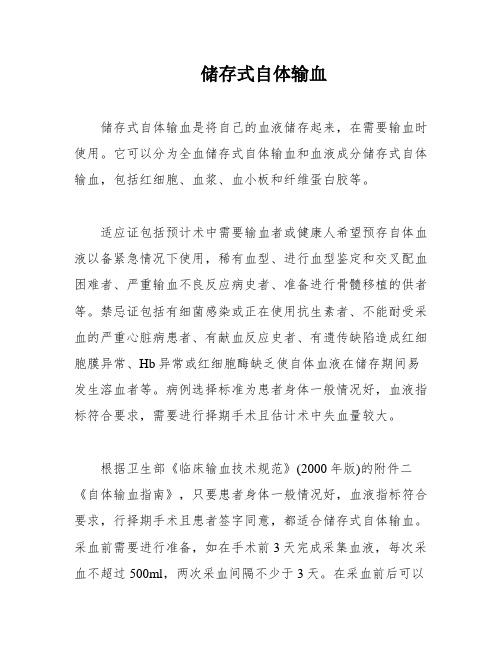
储存式自体输血储存式自体输血是将自己的血液储存起来,在需要输血时使用。
它可以分为全血储存式自体输血和血液成分储存式自体输血,包括红细胞、血浆、血小板和纤维蛋白胶等。
适应证包括预计术中需要输血者或健康人希望预存自体血液以备紧急情况下使用,稀有血型、进行血型鉴定和交叉配血困难者、严重输血不良反应病史者、准备进行骨髓移植的供者等。
禁忌证包括有细菌感染或正在使用抗生素者、不能耐受采血的严重心脏病患者、有献血反应史者、有遗传缺陷造成红细胞膜异常、Hb异常或红细胞酶缺乏使自体血液在储存期间易发生溶血者等。
病例选择标准为患者身体一般情况好,血液指标符合要求,需要进行择期手术且估计术中失血量较大。
根据卫生部《临床输血技术规范》(2000年版)的附件二《自体输血指南》,只要患者身体一般情况好,血液指标符合要求,行择期手术且患者签字同意,都适合储存式自体输血。
采血前需要进行准备,如在手术前3天完成采集血液,每次采血不超过500ml,两次采血间隔不少于3天。
在采血前后可以给患者铁剂、维生素C及叶酸等治疗。
但对于Hb<100g/L的患者及有细菌性感染的患者不能采集自体血。
此外,对于冠心病、严重主动脉瓣狭窄等心脑血管疾病及重症患者需要慎用。
在采血前,应根据需要储备的血量来确定开始采血的时间,以确保患者的Hct恢复到采血前的水平。
由于蛋白质的合成和恢复血容量到正常水平需要72小时,红细胞的恢复需要1周的时间,因此采血应在术前3天内进行,两次采血时间间隔不应少于3天。
按照XXX(AABB)的标准,只要患者每次采血前的Hb>110g/L,Hct>0.34,就可以进行采血。
成年人每次采血量通常为200ml或400ml,每次采血不超过500ml(或自身血容量的10%)。
老年人和身体较虚弱的人每次采血量应适当减少。
对于体重轻或儿童,采血量不宜过多,对于体重低于50kg的患者或儿童,可以参照8ml/kg的比例来估算每次采血量。
输血技术6:贮存式自体输血管理规程
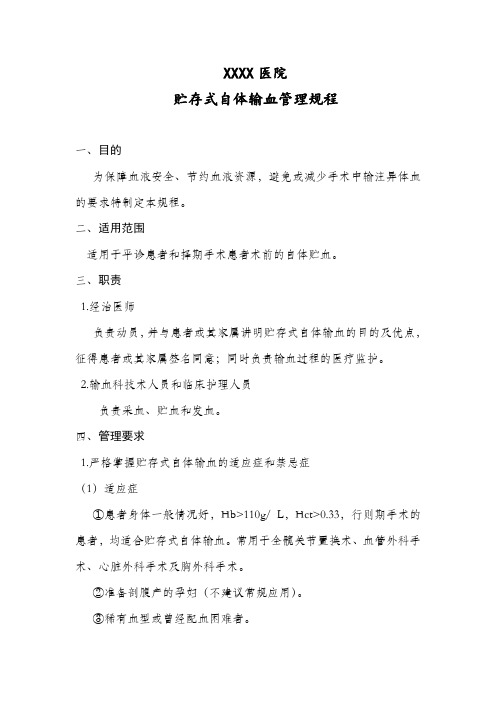
XXXX医院
贮存式自体输血管理规程
一、目的
为保障血液安全、节约血液资源,避免或减少手术中输注异体血的要求特制定本规程。
二、适用范围
适用于平诊患者和择期手术患者术前的自体贮血。
三、职责
1.经治医师
负责动员,并与患者或其家属讲明贮存式自体输血的目的及优点,征得患者或其家属签名同意;同时负责输血过程的医疗监护。
2.输血科技术人员和临床护理人员
负责采血、贮血和发血。
四、管理要求
1.严格掌握贮存式自体输血的适应症和禁忌症
(1)适应症
①患者身体一般情况好,Hb>110g/ L,Hct>0.33,行则期手术的患者,均适合贮存式自体输血。
常用于全髋关节置换术、血管外科手术、心脏外科手术及胸外科手术。
②准备剖腹产的孕妇(不建议常规应用)。
③稀有血型或曾经配血困难者。
自体血规范

江阴市中医院自体输血规范自体输血可以避免血源传播性病人和免疫抑制,对一时无法获得同型血的患者也是唯一血源。
自体输血有三种方法:贮存式自体输血、急性等容血液稀释(ANI-I)及回收式自体输血。
一、贮存式自体输血术前一定时间采集患者自体的血液进行保存,在手术期间输用。
1.只要患者身体一般情况好,血红蛋白>110g/l。
或红细胞压积>0.33,行择期手术。
患者签字同意都适合贮存式自体输血。
2.按相应的血液储存条件,手术前3天完成采集血液。
3.每次采血不超过500ml,(或自体血容量的10%),两次采血间隔不少于3天。
4.在采血前后可给患者铁剂、维生素C及叶酸(有条件的可应用重组人红细胞生成素)等治疗。
5.血红蛋白<110g/l的患者及有细菌性感染的患者不能采集自体血。
6.对冠心病、严重主动脉瓣狭窄等心脑血管疾病及重症患者慎用。
二、急性等容血液稀释(ANIT)ANH一般在麻醉后、手术主要出血步骤开始前,抽取患者一定量自体血在室温下保存备用,同时输入胶体溶液或等渗晶体液补充血容量,使血液适度稀释,降低红细胞压积,使手术出血时血液的有形成份丢失减少。
然后根据术中失血及患者情况将自体血回输给患者。
1、患者体体一般情况好,血红蛋白<110g/l(红细胞压积>=0.33),估计术中有大量失血,可以考虑进行ANH.2、手术需要降低血液粘稠度,改善微循环灌流时,也可采用。
3、血液稀释程度,一般使红细胞压积不低于0.25.4、术中必须密切监测血压,脉搏、血氧饱和度、红细胞压积和尿量的变化,必要时应监测中心静脉压5、下列患者不宜进行血液稀释:血红蛋白<100g/l,低蛋白血症、凝血障碍,静脉输液通路不畅,及不具备监护条件的三、回收式自体输血血液回收是指用血液回收装置,将患者体腔积血、手术中失血即术后引流血液进行回收、抗凝、滤过、洗涤等处理,然后回输给患者。
血液回收必须采用合格的设备,回收处理的血必须达到一定的质量标准。
自体输血制度与技术管理规范
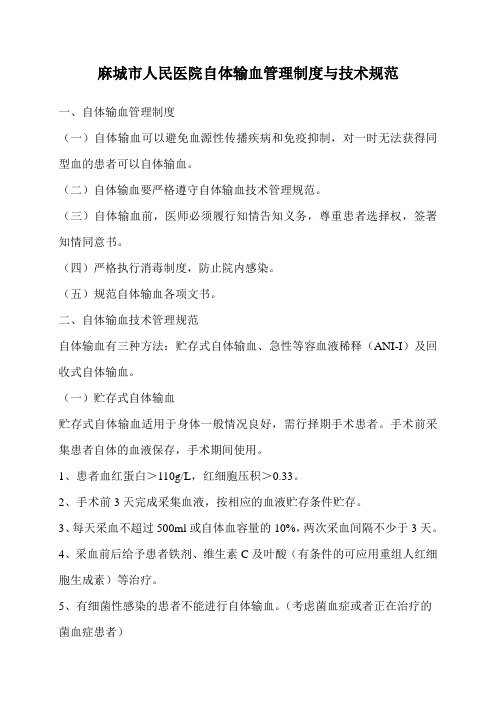
麻城市人民医院自体输血管理制度与技术规范一、自体输血管理制度(一)自体输血可以避免血源性传播疾病和免疫抑制,对一时无法获得同型血的患者可以自体输血。
(二)自体输血要严格遵守自体输血技术管理规范。
(三)自体输血前,医师必须履行知情告知义务,尊重患者选择权,签署知情同意书。
(四)严格执行消毒制度,防止院内感染。
(五)规范自体输血各项文书。
二、自体输血技术管理规范自体输血有三种方法:贮存式自体输血、急性等容血液稀释(ANI-I)及回收式自体输血。
(一)贮存式自体输血贮存式自体输血适用于身体一般情况良好,需行择期手术患者。
手术前采集患者自体的血液保存,手术期间使用。
1、患者血红蛋白>110g/L,红细胞压积>0.33。
2、手术前3天完成采集血液,按相应的血液贮存条件贮存。
3、每天采血不超过500ml或自体血容量的10%,两次采血间隔不少于3天。
4、采血前后给予患者铁剂、维生素C及叶酸(有条件的可应用重组人红细胞生成素)等治疗。
5、有细菌性感染的患者不能进行自体输血。
(考虑菌血症或者正在治疗的菌血症患者)6、冠心病、严重主动脉瓣狭窄等心脑血管疾病及重症患者慎用自体输血。
(二)急性等容血液稀释急性等容血液稀释一般在麻醉后,手术主要出血步骤开始前,抽取一定量的自体血在室温下保存备用,同时输入胶体液或等渗晶体液补充血容量,使血液适度稀释,降低红细胞压积,是手术出血时血液的有形成分丢失减少,然后根据术中失血及患者情况将自体血回输给患者。
1、患者身体一般情况良好,血红蛋白≥110g/L,红细胞压积≥0.33,估计术中有大量失血,可以进行急性等容血液稀释。
2、手术需要降低血液粘稠度,改善微循环灌流时,也可采用。
3、血液稀释程度,一般维持红细胞压积不低于0.25。
4、术中必须密切监测患者血压、脉搏、血氧饱和度,红细胞压积和尿量变化,必要时监测中心静脉压。
5、等容量血液稀释收集的血液在输注前保存在下述条件下:室温保存8小时(收集时开始计时)、8小时之内放入1-6℃的冰箱可保存24小时。
储存式自体输血

储存式自体输血储存式自体输血可分为全血储存式自体输血和血液成分储存式自体输血。
血液成分储存式自体输血包括红细胞、血浆、血小板和纤维蛋白胶等。
一、适应证与禁忌证及病例选择标准(—)适应证1.一般情况好,预计术中需要输血者或健康人希望预存自体血液以备紧急情况下使用。
2.稀有血型、进行血型鉴定和交叉配血困难者、有多种红细胞抗体或对高频率抗原的同种抗体所致的对所有异体血不配合者。
3.曾有严重输血不良反应病史者或因输血产生同种免疫性抗体者,如血小板无效输注、IgA缺乏、有白细胞抗体者。
4.准备进行骨髓移植的供者在采髓前必须预存自体血液,以便抽取骨髓时回输。
5.边远地区供血困难,但手术需输血者。
6.避免分娩时输异体血(如剖宫产)的孕妇。
(二)禁忌证1.有细菌感染或正在使用抗生素者。
2.不能耐受采血的严重主动脉瓣狭窄症、室性心律不齐、新近的心肌梗死症、不稳定的心绞痛、严重的高血压、充血性心力衰竭和服用抑制代偿性心血管反应的药物者。
3.有献血反应史者或曾经在献血后发生过迟发性昏厥者(如献血后30-60分钟,甚至数小时内虚脱或意识丧失者)或有活动性癫痫病史者。
4.有遗传缺陷造成红细胞膜异常、Hb异常或红细胞酶缺乏使自体血液在储存期间易发生溶血者。
5.有贫血、出血、血压偏低和肝肾功能不全者。
6.血小板计数小于50×109/L、血小板功能异常、伴有造血系统疾病或凝血系统功能异常者。
(三)病例选择标准患者身体一般情况好,Hh>110g/L,Hct>0.33,血小板计数>100×l09/L,凝血酶原时间正常,行择期手术,估计术中失血1000ml以上者。
我国卫生部《临床输血技术规范》(2000年版)附件二《自体输血指南》规定:1.只要患者身体一般情况好,Hb>110g/L或Hct>0.33,行择期手术,患者签字同意,都适合储存式自体输血。
2.按相应的血液储存条件,手术前3天完成采集血液。
储存式自体输血取血标准操作程序
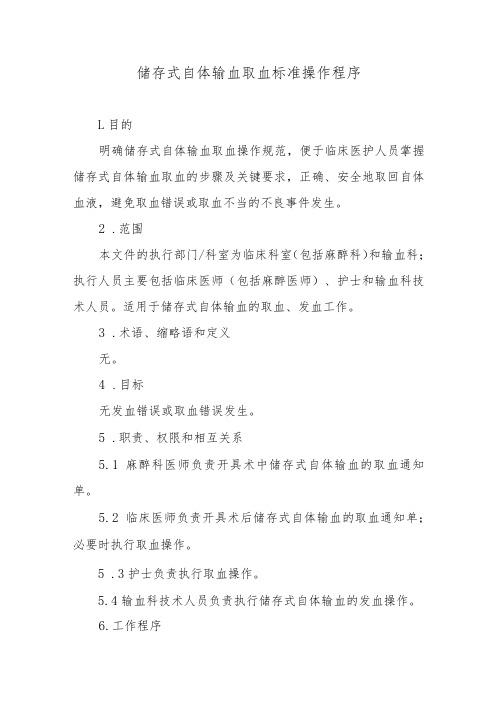
储存式自体输血取血标准操作程序L目的明确储存式自体输血取血操作规范,便于临床医护人员掌握储存式自体输血取血的步骤及关键要求,正确、安全地取回自体血液,避免取血错误或取血不当的不良事件发生。
2.范围本文件的执行部门/科室为临床科室(包括麻醉科)和输血科;执行人员主要包括临床医师(包括麻醉医师)、护士和输血科技术人员。
适用于储存式自体输血的取血、发血工作。
3.术语、缩略语和定义无。
4.目标无发血错误或取血错误发生。
5.职责、权限和相互关系5.1麻醉科医师负责开具术中储存式自体输血的取血通知单。
5.2临床医师负责开具术后储存式自体输血的取血通知单;必要时执行取血操作。
5.3护士负责执行取血操作。
5.4输血科技术人员负责执行储存式自体输血的发血操作。
6.工作程序6.1申请临床医师或麻醉科医师开具储存式自体输血取血通知单。
(1)通过输血信息系统查询自体采血已完成,确认患者需要输血后,在输血信息系统中选择“储存式自体输血取血”,勾选需要取回的自体血液,填写《临床取血通知单》(SYSX-ZD-017/FJ1),发送至输血科。
(2)将系统生成附带条码的《临床取血通知单》打印出来,签名后交取血人。
6.2取血(1)取血人持《临床取血通知单》,携带专用取血箱至输血科窗口取血。
(2)取血人在取血窗口将《临床取血通知单》填写完毕交输血科发血人。
(3)发血人确认《临床取血通知单》填写规范、完整,审核取血人具备取血资格后,根据取血通知单取出相应血液,核对以下信息无误后,在信息系统执行发血操作,打印《自体输血发血记录单》(SYSX-ZD-17/FJ3)并签名。
①血液标签信息与取血通知单上的信息(患者姓名、性别、年龄、身份证号、血型、采血时间、储存时间、有效期)完全相符;②检查、确认血液外观正常、无渗漏、在有效期以内;③血袋标签上的血型有复查签名。
(4)取、发血双方共同核对取血通知单、自体血液标签及发血记录单,核对内容同6.2的(3)o(5)双方核对无误后,在输血科发血记录本上签名,《临床取血通知单》由输血科存档保存;取血人将自体血液及发血记录单装入专用取血箱运送回科室或手术室。
《临床输血检验技术》课件——贮存式自体输血
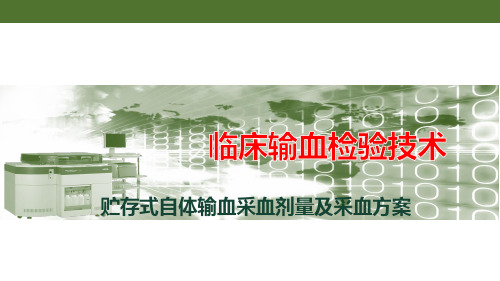
方案三
转换式采血法:适用于术前要求提供较多 新鲜自体全血
转换式采血法日程表
采血时间 术前4周 术前3周 术前2周 术前1周 术前0周
采血次数
第一次
第二次
第三次
第四次
无
采血量(ml) 400
800
1200
1600
0
回输量(ml)
0
400
800
00
1200
1600
1600
贮存式自体输血(PAD)
在患者使用血液之前采 集患者的血液和(或) 血液成分并进行适当保 存,当患者需要实施输 血时,将其预先采集并 贮存的血液和(或)血 液成分进行回输
不良反应
局部反 应
全身反 应
其他反 应
1、血肿:可采 血12小时后热敷 消除
2、局部感染
1、血管迷走神 经反应:如低血 压、心动过速、 肌肉抽搐、恶心 呕吐、呼吸困难、 晕厥等 2、全身性感染
练习:
下列哪些患者能使用贮存式自体输血(
)
A、怀孕8个月的孕妇
B、主动脉狭窄的患者需做阑尾切除术
C、红细胞不规则抗体检查阳性
D、菌血症患者
E、10岁体重30Kg的患者
采血 准备
采血 操作
采血 后处 理
1、检查采血袋、采血秤 2、认真消毒 3、核对信息,做好标注
1、选择静脉穿刺部位 2、皮肤消毒并检查采血器具 3、严格按照无菌操作静脉穿刺 4、保持血流通畅,关注患者情况
1、核对信息,热合导管 2、将导管内的血转移至试管 3、记录、签字,做好消毒
贮存式自体输血不良反应及注意事项
1200
采血方案
方案二
蛙跳式采血:适用于较大及复杂的手术,要求 术前提供较多的自体血
贮存式自身输血统一标准操作作业规程

贮存式本身输血标准操作规程1.原理或目标:术(产)前一定时间采集患者本身血液进行保留,在术中、产前或产时输用。
这么既能够保留输血优点,又能够避免输异体血引发感染和溶血反应危险,癌症患者可降低肿瘤复发、转移机率。
2.适应症:2.1患者或产妇身体通常情况好,体重45kg(产妇体重55kg)及以上;体温正常,血压:90-140/60-90mmHg,脉差大于30 mmHg;心、肺、肝、肾功效正常;血红蛋≥110g/L或红细胞压积≥0.33;血小板计数≥100×109/L,长久血小板低下且无任何出血倾向者可放宽至血小板>80×109/L且血小板功效正常;凝血功效正常。
2.2估量术中、产前、产时出血较多有可能输血者,如恶性肿瘤、巨大肿块、广泛粘连、前置胎盘、前次剖宫产、妊娠合并子宫肌瘤或子宫肌瘤手术史、多胎妊娠、巨大儿、羊水过多、有产后出血史等;2.3稀有血型;2.4.既往数次同种输血,或既往有严重同种输血反应者;2.5.因宗教信仰或其它原因不愿接收同种输血者。
3.禁忌症:3.1血红蛋白<100g/L;低蛋白血症;凝血功效障碍。
3.2发烧、菌血症(ANH不受此限制)。
3.3高血压病、脑血管病、冠心病不稳定型心绞痛、主动脉瓣狭窄。
3.4黄疸病人。
3.5心、肺、肝、肾等关键器官功效不全。
3.6 子痫及子痫前期、胎儿宫内生长受限、胎儿窘迫,胎膜早破≥二十四小时。
4.临床医生操作程序4.1医生估量未来可能失血量,决定采血量、采血方法和采血时机。
4.2采血方法、量和时机:每次采血量应掌握在8mL/kg左右。
(1)单纯式采血适适用于估计出血量和需要备血量较小患者。
仅采400ml者,提前3~5天;采800ml~1200ml者需提前14~21天。
(2)蛙跳式采血适适用于估计出血量和需要备血量较大者。
(3)转换式采血提前30天采血400mL,间隔7天后采800mL,同时回输上次采血量,第3次采血1200mL,同时回输第2次全部采血量,以这类推。
输血科实施储存式自体输血的规定

输血科实施储存式自体输血的规定I目的为了自体输血的管理,特制定此规定。
Il范围本制度适用于输血科工作人员。
Ill规定近年来,血源紧缺一直制约着我院临床医疗业务的正常开展,特别是用血量较大的手术更是难于开展,为最大限度缓解血源紧缺局面,更好保证临床用血安全,依据卫生部《医疗机构临床用血管理办法》,经医院临床用血管理委员会讨论决定开展自体输血业务,规定如下:一、储存式自体输血简介储存式自体输血是自体输血的一种形式,是指对患者血液和血液成分进行有计划分阶段的采集、保存,当患者在择期手术的术中、术后或将来需要时,再进行回输的一种输血方式。
二、储存式自体输血申请(一)对符合储存式自体输血适应症、无储存式自体输血禁忌症的患者,相关临床科室必须积极动员其进行储存式自体输血。
(二)申请储存式自体输血应由经治医师逐项填写《储存式自体输血申请单》,由科主任核准签字,送输血科预约采集日期。
(三)申请储存式自体输血前,经治医师应向患者或其家属说明储存式自体输血的采血量及采血时间、优点、风险等,征得患者或家属的同意,并在《储存式自体输血知情同意书》上签字。
《储存式自体输血知情同意书》随病历归档。
三、血液采集、储存(一)血液采集及储存由输血科负责。
(二)输血科根据自体血采集原则,结合患者状况决定采血量及次数。
(三)无菌操作采集患者自身血液。
血液采集前需出示身份证件。
输血科须配备献血不良反应的急救药品和器材。
血液采集过程中,须由经治医师陪同,遇献血不良反应进行紧急处理。
(四)采集完毕,在血袋贴上患者主要信息标签(含姓名、科室、ID号、血型、血量、采血时间、有效期),储存于有明显标识的自体血冰箱。
填写自体输血回执单交与经治医师,作为领血凭据。
(五)检测ABO血型和Rh(D)血型,做好入库登记。
四、发血和输血储存式自体输血发血、输血依照卫生部《临床输血技术规范》(卫医发(2000)184号)及我院《临床输血管理制度》的要求执行。
储存式自体输血技术管理制度
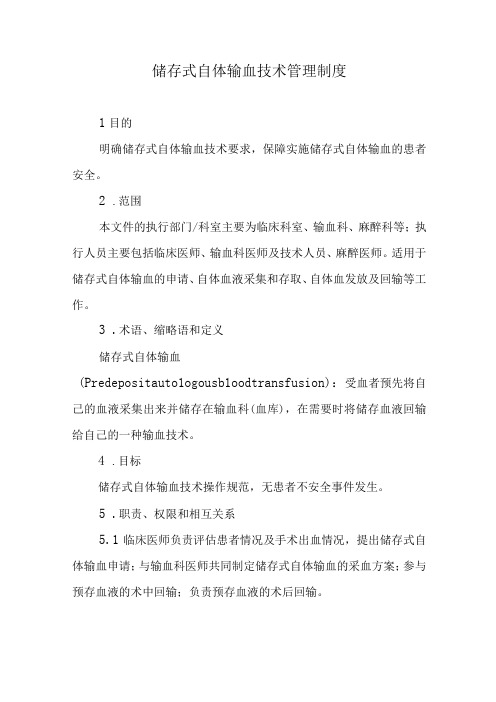
储存式自体输血技术管理制度1目的明确储存式自体输血技术要求,保障实施储存式自体输血的患者安全。
2.范围本文件的执行部门/科室主要为临床科室、输血科、麻醉科等;执行人员主要包括临床医师、输血科医师及技术人员、麻醉医师。
适用于储存式自体输血的申请、自体血液采集和存取、自体血发放及回输等工作。
3.术语、缩略语和定义储存式自体输血(Predepositauto1ogousb1oodtransfusion):受血者预先将自己的血液采集出来并储存在输血科(血库),在需要时将储存血液回输给自己的一种输血技术。
4.目标储存式自体输血技术操作规范,无患者不安全事件发生。
5.职责、权限和相互关系5.1临床医师负责评估患者情况及手术出血情况,提出储存式自体输血申请;与输血科医师共同制定储存式自体输血的采血方案;参与预存血液的术中回输;负责预存血液的术后回输。
1.2输血科医师负责与临床医师共同制定储存式自体输血的采血方案,负责采血过程中患者的监护。
1.3输血科工作人员(含医生、护士)负责储存式自体输血的血液采集、保存、发放。
5.4麻醉科医师负责预存血液的术中回输。
6.5临床护理人员参与预存血液的回输及患者的监护。
7.工作程序6.1适应证:稀有血型、血型鉴定及交叉配血困难和预计出血量较大;既往发生过严重输血反应;拒绝接受异体输血;自愿要求且满足实施条件的择期手术患者。
6.2禁忌证:贫血;发热、感染;严重高血压、冠心病、不稳定心绞痛、主动脉瓣狭窄和脑血管病;重要器官功能不全;产科先兆子痫和胎儿发育迟缓以及其他增加患者风险的情况。
6.3病例选择(1)估计术中失血50Om1以上,术前Hb2110g∕1,Hct233%的患者;(2)无年龄限制;(3)心血管状况良好,有良好的肘前静脉提供穿刺;(4)患者有很好的理解和配合;(5)无体重限制(患者因近期生病或营养不良导致体重下降除外);(6)非紧急情况下的以下择期手术:心血管系统疾病(先天性心脏病手术、瓣膜病手术、冠状动脉分流术、大动脉成形术)、腹部内脏系统疾病(泌尿生殖系统、胆石症、肾结石等各种脏器手术、脏器肿瘤的切除术)、骨、关节系统疾病(脊柱成形术、关节成形术)、前置胎盘的孕妇等。
储存式自体输血

储存式自体输血储存式自体输血可分为全血储存式自体输血和血液成分储存式自体输血。
血液成分储存式自体输血包括红细胞、血浆、血小板和纤维蛋白胶等。
一、适应证与禁忌证及病例选择标准(—)适应证1.一般情况好,预计术中需要输血者或健康人希望预存自体血液以备紧急情况下使用。
2.稀有血型、进行血型鉴定和交叉配血困难者、有多种红细胞抗体或对高频率抗原的同种抗体所致的对所有异体血不配合者。
3.曾有严重输血不良反应病史者或因输血产生同种免疫性抗体者,如血小板无效输注、IgA缺乏、有白细胞抗体者。
4.准备进行骨髓移植的供者在采髓前必须预存自体血液,以便抽取骨髓时回输。
5.边远地区供血困难,但手术需输血者。
6.避免分娩时输异体血(如剖宫产)的孕妇。
(二)禁忌证1.有细菌感染或正在使用抗生素者。
2.不能耐受采血的严重主动脉瓣狭窄症、室性心律不齐、新近的心肌梗死症、不稳定的心绞痛、严重的高血压、充血性心力衰竭和服用抑制代偿性心血管反应的药物者。
3.有献血反应史者或曾经在献血后发生过迟发性昏厥者(如献血后30-60分钟,甚至数小时内虚脱或意识丧失者)或有活动性癫痫病史者。
4.有遗传缺陷造成红细胞膜异常、Hb异常或红细胞酶缺乏使自体血液在储存期间易发生溶血者。
5.有贫血、出血、血压偏低和肝肾功能不全者。
6.血小板计数小于50×109/L、血小板功能异常、伴有造血系统疾病或凝血系统功能异常者。
(三)病例选择标准患者身体一般情况好,Hh>110g/L,Hct>0.33,血小板计数>100×l09/L,凝血酶原时间正常,行择期手术,估计术中失血1000ml以上者。
我国卫生部《临床输血技术规范》(2000年版)附件二《自体输血指南》规定:1.只要患者身体一般情况好,Hb>110g/L或Hct>0.33,行择期手术,患者签字同意,都适合储存式自体输血。
2.按相应的血液储存条件,手术前3天完成采集血液。
孕产妇贮存式自体输血
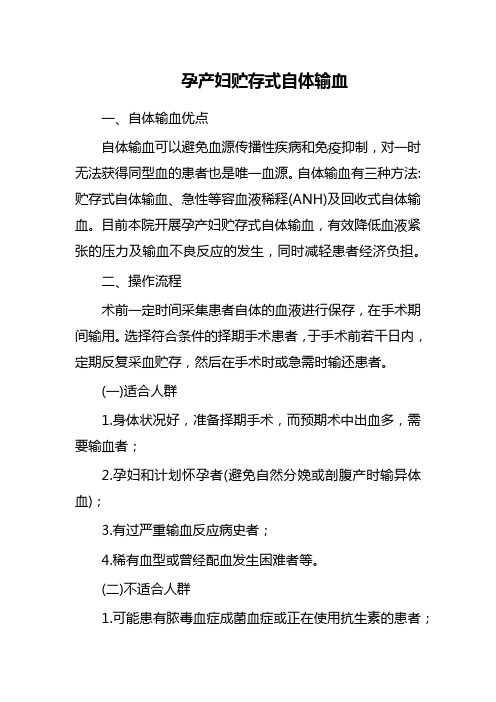
孕产妇贮存式自体输血
一、自体输血优点
自体输血可以避免血源传播性疾病和免疫抑制,对一时无法获得同型血的患者也是唯一血源。
自体输血有三种方法:贮存式自体输血、急性等容血液稀释(ANH)及回收式自体输血。
目前本院开展孕产妇贮存式自体输血,有效降低血液紧张的压力及输血不良反应的发生,同时减轻患者经济负担。
二、操作流程
术前一定时间采集患者自体的血液进行保存,在手术期间输用。
选择符合条件的择期手术患者,于手术前若干日内,定期反复采血贮存,然后在手术时或急需时输还患者。
(一)适合人群
1.身体状况好,准备择期手术,而预期术中出血多,需要输血者;
2.孕妇和计划怀孕者(避免自然分娩或剖腹产时输异体血);
3.有过严重输血反应病史者;
4.稀有血型或曾经配血发生困难者等。
(二)不适合人群
1.可能患有脓毒血症成菌血症或正在使用抗生素的患者;
2.肝肾功能不良者;
3.有严重心脏疾患者;
4.贫血、出血及血压偏低者;
5.有献血史并发生过迟发性昏厥者;
6.采血可能诱发疾病发作或加重的患者;
7.血液受胃肠道内容物、消化液或尿液等污染者;
8.血液可能受恶性肿瘤细胞玷污者;
9.凝血因子缺乏者等。
三、开展情况
我院在率先开展孕产妇预存式自体输血技术,目前已累计开展140多例。
自体血回输技术规范
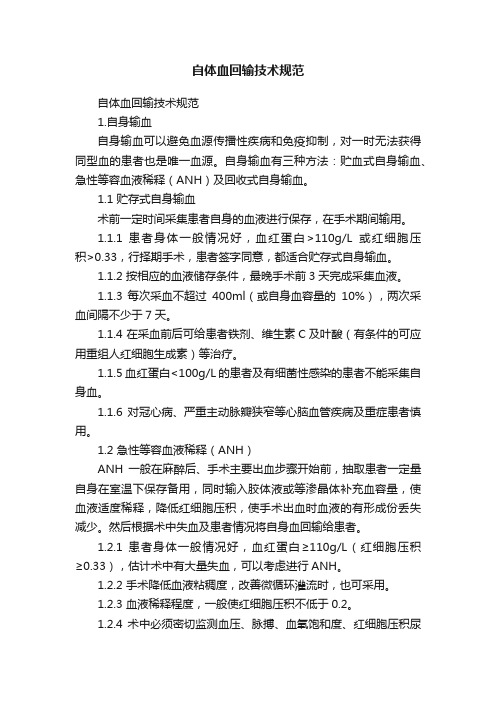
自体血回输技术规范自体血回输技术规范1.自身输血自身输血可以避免血源传播性疾病和免疫抑制,对一时无法获得同型血的患者也是唯一血源。
自身输血有三种方法:贮血式自身输血、急性等容血液稀释(ANH)及回收式自身输血。
1.1 贮存式自身输血术前一定时间采集患者自身的血液进行保存,在手术期间输用。
1.1.1 患者身体一般情况好,血红蛋白>110g/L或红细胞压积>0.33,行择期手术,患者签字同意,都适合贮存式自身输血。
1.1.2 按相应的血液储存条件,最晚手术前3天完成采集血液。
1.1.3 每次采血不超过400ml(或自身血容量的10%),两次采血间隔不少于7天。
1.1.4 在采血前后可给患者铁剂、维生素C及叶酸(有条件的可应用重组人红细胞生成素)等治疗。
1.1.5 血红蛋白<100g/L的患者及有细菌性感染的患者不能采集自身血。
1.1.6 对冠心病、严重主动脉瓣狭窄等心脑血管疾病及重症患者慎用。
1.2 急性等容血液稀释(ANH)ANH一般在麻醉后、手术主要出血步骤开始前,抽取患者一定量自身在室温下保存备用,同时输入胶体液或等渗晶体补充血容量,使血液适度稀释,降低红细胞压积,使手术出血时血液的有形成份丢失减少。
然后根据术中失血及患者情况将自身血回输给患者。
1.2.1 患者身体一般情况好,血红蛋白≥110g/L(红细胞压积≥0.33),估计术中有大量失血,可以考虑进行ANH。
1.2.2 手术降低血液粘稠度,改善微循环灌流时,也可采用。
1.2.3 血液稀释程度,一般使红细胞压积不低于0.2。
1.2.4 术中必须密切监测血压、脉搏、血氧饱和度、红细胞压积尿量的变化,必要时应监测患者静脉压。
1.2.5 下列患者不宜进行血液稀释:血红蛋白<100g/L,低蛋白血症,凝血机能障碍,静脉输液通路不畅及不具备监护条件的。
1.3 回收式自身输血血液回收是指用血液回收装置,将患者体腔积血、手术失血及术后引流血液进行回收、抗凝、滤过、洗涤等处理,然后回输给患者。
自体输血制度与技术管理规范

XXX医院自体输血管理制度与技术规范一、自体输血管理制度一自体输血可以避免血源性传播疾病和免疫抑制,对一时无法获得同型血的患者可以自体输血;二自体输血要严格遵守自体输血技术管理规范;三自体输血前,医师必须履行知情告知义务,尊重患者选择权,签署知情同意书;四严格执行消毒制度,防止院内感染;五规范自体输血各项文书;二、自体输血技术管理规范自体输血有三种方法:贮存式自体输血、急性等容血液稀释ANI-I及回收式自体输血;(一)贮存式自体输血贮存式自体输血适用于身体一般情况良好,需行择期手术患者;手术前采集患者自体的血液保存,手术期间使用;1、患者血红蛋白>110g/L,红细胞压积>0.33;2、手术前3天完成采集血液,按相应的血液贮存条件贮存;3、每天采血不超过500ml或自体血容量的10%,两次采血间隔不少于3天;4、采血前后给予患者铁剂、维生素C及叶酸有条件的可应用重组人红细胞生成素等治疗;5、有细菌性感染的患者不能进行自体输血;考虑菌血症或者正在治疗的菌血症患者6、冠心病、严重主动脉瓣狭窄等心脑血管疾病及重症患者慎用自体输血;二急性等容血液稀释急性等容血液稀释一般在麻醉后,手术主要出血步骤开始前,抽取一定量的自体血在室温下保存备用,同时输入胶体液或等渗晶体液补充血容量,使血液适度稀释,降低红细胞压积,是手术出血时血液的有形成分丢失减少,然后根据术中失血及患者情况将自体血回输给患者;1、患者身体一般情况良好,血红蛋白≥110g/L,红细胞压积≥0.33,估计术中有大量失血,可以进行急性等容血液稀释;2、手术需要降低血液粘稠度,改善微循环灌流时,也可采用;3、血液稀释程度,一般维持红细胞压积不低于0.25;4、术中必须密切监测患者血压、脉搏、血氧饱和度,红细胞压积和尿量变化,必要时监测中心静脉压;5、等容量血液稀释收集的血液在输注前保存在下述条件下:室温保存8小时收集时开始计时、8小时之内放入1-6℃的冰箱可保存24小时;6、下列情况不宜进行血液稀释:1患者血红蛋白<100g/L;2低蛋白血症;3凝血机制障碍;4静脉输液通路不畅;5不具备监护条件;三回收或自体输血回收或自体输血是使用血液回收装置,将患者体腔积血、手术中出血及术后引流血液进行回收、抗凝、过滤、洗涤等处理,然后回输给患者;1、血液回收必须采用合格设备,使用设备必须无致热源,并含有阻挡对受体有潜在危险的微粒的过滤器,防止空气栓塞;2、回收血液必须达到质量标准;血液收集和重输的方法必须安全、无菌和保证收集血液及成分的正确性;3、血液在输注前加温,不要超过38℃;4、体外循环后的机器全血尽可能回输给患者;5、有下列情况禁止回收自体输血;1血液流出血管外超过6小时;2流出的血液可能被细菌、分辨、羊水或消毒液污染;3流出血液可能会有癌细胞;4流出的血液严重溶血;。
- 1、下载文档前请自行甄别文档内容的完整性,平台不提供额外的编辑、内容补充、找答案等附加服务。
- 2、"仅部分预览"的文档,不可在线预览部分如存在完整性等问题,可反馈申请退款(可完整预览的文档不适用该条件!)。
- 3、如文档侵犯您的权益,请联系客服反馈,我们会尽快为您处理(人工客服工作时间:9:00-18:30)。
储存式自体输血标准
英文回答:
Autologous blood transfusion is a procedure where a patient donates their own blood before a scheduled surgery or medical procedure, which is then stored and later transfused back into their own body. This method eliminates the need for receiving blood from a donor, reducing the
risk of complications such as transfusion reactions and infections.
There are certain criteria and standards that need to be met in order for a patient to be eligible for autologous blood transfusion. These include:
1. Hemoglobin levels: The patient's hemoglobin levels need to be within a certain range to ensure that they have enough healthy red blood cells to support their body's oxygen needs. Typically, a minimum hemoglobin level of 11 grams per deciliter (g/dL) is required for autologous blood
donation.
2. General health: The patient should be in good
overall health and free from any medical conditions that may affect their ability to donate blood or tolerate the procedure.
3. Adequate time before surgery: The patient needs to have enough time before their scheduled surgery to donate blood and for it to be processed and stored. Generally, autologous blood donation should take place at least 4 to 6 weeks before the surgery.
4. Adequate blood volume: The patient needs to have a sufficient blood volume to donate, which typically ranges from 400 to 500 milliliters (mL) per donation. This ensures that enough blood is available for transfusion during the surgery.
5. Informed consent: The patient needs to provide informed consent for the procedure, understanding the benefits and risks involved.
It's important to note that the specific criteria and standards for autologous blood transfusion may vary depending on the hospital or healthcare facility. It's always best to consult with your healthcare provider to determine if you meet the requirements for autologous blood transfusion.
中文回答:
储存式自体输血是一种在手术或医疗程序之前,患者捐献自己的血液,然后将其储存起来,最后再输回自己体内的过程。
这种方法消除了从供血者接受血液的需要,减少了输血反应和感染等并发症的风险。
要符合储存式自体输血的条件和标准,有以下要求:
1. 血红蛋白水平,患者的血红蛋白水平需要在一定范围内,以确保他们有足够的健康红细胞来支持身体的氧气需求。
通常,储存式自体输血要求血红蛋白水平不低于11克/分升。
2. 总体健康状况,患者应身体健康,并没有任何可能影响他们
捐献血液或耐受手术的医疗条件。
3. 手术前充足的时间,患者需要在预定手术前有足够的时间捐献血液,并进行处理和储存。
通常,储存式自体输血应在手术前至少4到6周进行。
4. 充足的血液容量,患者需要有足够的血液容量进行捐献,通常每次捐献的血液容量为400到500毫升。
这样可以确保手术期间有足够的血液输注。
5. 知情同意,患者需要对该过程提供知情同意,了解涉及的利益和风险。
需要注意的是,储存式自体输血的具体标准和要求可能因医院或医疗机构而异。
最好咨询您的医疗提供者,以确定是否符合储存式自体输血的要求。
